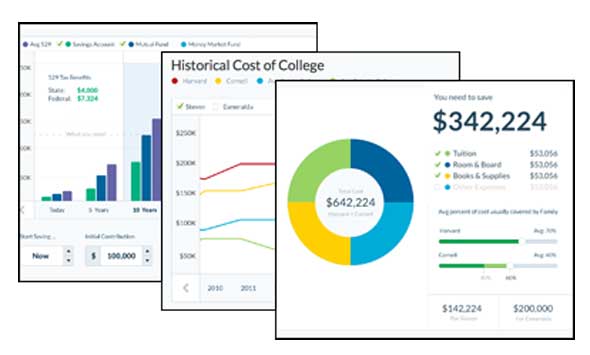{{parent.cta_data.text}}
COLLEGE SAVINGS 101

9 college savings tips to start the year off right
http://www.savingforcollege.com/articles/9-college-savings-tips-to-start-the-year-off-right-706
Updated: 2016-12-22
Is saving for college is on your 2017 to-do list? Whether youíre just getting started or staying on track, the following slideshow offers tips to help you meet your goals.
If You Already Have a 529 Plan:

1. Check to make sure youíre hitting your savings targets
-
† †
- Are you aiming to put away a certain amount each month? † †
- Do you have a total dollar amount you want to save over time? † † †
- If youíre not hitting your targets, what adjustments should be made for 2017?

2. Update your goal if thereís been any major changes in your household
-
† †
- If youíve moved out of state, should you change 529 plans to take advantage of potential state tax breaks? † †
- If you welcomed a new family member, should you open another 529 plan? † †
- Has your household income changed due to a job loss or promotion? If so, think about whether your current contribution amounts still make sense.

3. Review your planís performance
-
† †
- You can look up the performance of your investment option on your 529 planís website or in the quarterly report. † † †
- How does the growth of your 529 plan look compared to the growth of your retirement account (net of fees) over the same time period? † †
- Check Savingforcollege.comís quarterly performance rankings to see where your plan stacks up against other 529 plans.

4. Decide if you need to make an investment change
-
† †
- In December 2014 President Obama signed the ABLE Act into law, which allows disabled Americans to take advantage of tax-deferred savings for education, housing and other expenses related to living with a disability. † †
- The Act has also made a change to traditional 529 college savings plans that allows for twice-yearly investment changes (the limit was previously one change per year). † †
- If your investment objectives have changed or your current portfolio is underperforming you have two opportunities to make a change this year.
If You Donít Have a 529 Plan Yet:

5. Set a savings goal
-
† †
- Consider the age of the beneficiary and when the first tuition bill will be due. Remember you can continue to save while attending college so you wonít need the full amount all at once. † †
- Think about public vs. private and in state vs. out-of-state colleges Ė this can make a big difference in the total amount you need to save. † †
- Will there be any other sources of funds to pay for college? Grandparents, financial aid, scholarships?

6. Do your homework - research 529 plans
-
† †
- Check out your home stateís plan first to see if any tax breaks are offered for residents. † † †
- Remember that fees and expenses, as well as investment options, can vary among 529 plans. † † †
- Savingforcollege.com offers a helpful tool that lets you compare plans by different features.

7. Enroll in your plan
-
† †
- 529 accounts can be opened directly through the planís website or through a financial advisor. † †
- Youíll likely pay a sales charge if you invest in an advisor-sold plan, but you may benefit from working with a professional. † †
- If youíre comfortable selecting a plan on your own, visit your planís detail page on Savingforcollege.com for more information on how you can enroll.

9. Try the Path to College Savings!
-
† †
- Whether youíre looking to open your first 529 plan or youíve been saving for years, the free Path to College Savings can help. † †
- The Path features interactive charts and graphics to show users how different decisions can impact their goals. † † †
- Set realistic goals based on your school choice and find the best plan for your familyís needs.
Originally Posted: 2015-01-07
Is saving for college is on your 2017 to-do list? Whether youíre just getting started or staying on track, the following slideshow offers tips to help you meet your goals.
If You Already Have a 529 Plan:

1. Check to make sure youíre hitting your savings targets
-
† †
- Are you aiming to put away a certain amount each month? † †
- Do you have a total dollar amount you want to save over time? † † †
- If youíre not hitting your targets, what adjustments should be made for 2017?

2. Update your goal if thereís been any major changes in your household
-
† †
- If youíve moved out of state, should you change 529 plans to take advantage of potential state tax breaks? † †
- If you welcomed a new family member, should you open another 529 plan? † †
- Has your household income changed due to a job loss or promotion? If so, think about whether your current contribution amounts still make sense.

3. Review your planís performance
-
† †
- You can look up the performance of your investment option on your 529 planís website or in the quarterly report. † † †
- How does the growth of your 529 plan look compared to the growth of your retirement account (net of fees) over the same time period? † †
- Check Savingforcollege.comís quarterly performance rankings to see where your plan stacks up against other 529 plans.

4. Decide if you need to make an investment change
-
† †
- In December 2014 President Obama signed the ABLE Act into law, which allows disabled Americans to take advantage of tax-deferred savings for education, housing and other expenses related to living with a disability. † †
- The Act has also made a change to traditional 529 college savings plans that allows for twice-yearly investment changes (the limit was previously one change per year). † †
- If your investment objectives have changed or your current portfolio is underperforming you have two opportunities to make a change this year.
If You Donít Have a 529 Plan Yet:

5. Set a savings goal
-
† †
- Consider the age of the beneficiary and when the first tuition bill will be due. Remember you can continue to save while attending college so you wonít need the full amount all at once. † †
- Think about public vs. private and in state vs. out-of-state colleges Ė this can make a big difference in the total amount you need to save. † †
- Will there be any other sources of funds to pay for college? Grandparents, financial aid, scholarships?

6. Do your homework - research 529 plans
-
† †
- Check out your home stateís plan first to see if any tax breaks are offered for residents. † † †
- Remember that fees and expenses, as well as investment options, can vary among 529 plans. † † †
- Savingforcollege.com offers a helpful tool that lets you compare plans by different features.

7. Enroll in your plan
-
† †
- 529 accounts can be opened directly through the planís website or through a financial advisor. † †
- Youíll likely pay a sales charge if you invest in an advisor-sold plan, but you may benefit from working with a professional. † †
- If youíre comfortable selecting a plan on your own, visit your planís detail page on Savingforcollege.com for more information on how you can enroll.

8. Set it and forget it
-
† †
- Most 529 plans can be linked to your checking account for automatic recurring investments. † † †
- Minimum initial contributions are sometimes as little as $15 or $25. † †
- Some plans also offer automatic payroll deduction as another way to simplify saving.

9. Try the Path to College Savings!
-
† †
- Whether youíre looking to open your first 529 plan or youíve been saving for years, the free Path to College Savings can help. † †
- The Path features interactive charts and graphics to show users how different decisions can impact their goals. † † †
- Set realistic goals based on your school choice and find the best plan for your familyís needs.
Originally Posted: 2015-01-07
If you liked this post and think it would help others save for college, please share!
Recommended Articles
SPONSOR CONTENT
Financial Professionals
Top 529 College Savings Plans
One-year rankings are based on a plan's average investment returns over the last 12 months.
| State | Plan Name | |
|---|---|---|
| 1 | Nevada | USAA 529 Education Savings Plan |
| 2 | Florida | Florida 529 Savings Plan |
| 3 | New Jersey | NJBEST 529 College Savings Plan |
Three-year rankings are based on a plan's average annual investment returns over the last three years.
| State | Plan Name | |
|---|---|---|
| 1 | South Dakota | CollegeAccess 529 (Direct-sold) |
| 2 | Wisconsin | Edvest 529 |
| 3 | Nevada | USAA 529 Education Savings Plan |
Five-year rankings are based on a plan's average annual investment returns over the last five years
| State | Plan Name | |
|---|---|---|
| 1 | Indiana | CollegeChoice 529 Direct Savings Plan |
| 2 | Florida | Florida 529 Savings Plan |
| 3 | Alaska | T. Rowe Price College Savings Plan |
10-year rankings are based on a plan's average annual investment returns over the last ten years.
| State | Plan Name | |
|---|---|---|
| 1 | West Virginia | SMART529 WV Direct College Savings Plan |
| 2 | South Carolina | Future Scholar 529 College Savings Plan (Direct-sold) |
| 3 | Ohio | Ohio's 529 Plan, CollegeAdvantage |

 {{parent.title}}
{{parent.title}}
 Login
Login

